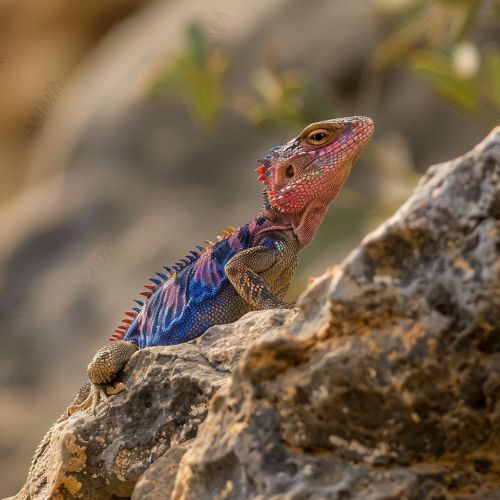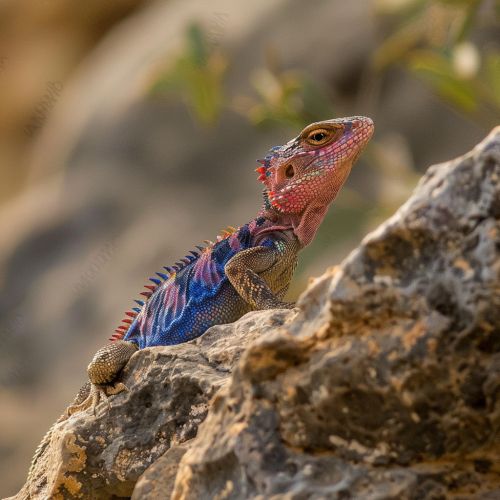Agamidae
Introduction
The Agamidae family, commonly known as agamas, is a diverse group of lizards found predominantly in Africa, Asia, Australia, and a few parts of Southern Europe. This family is notable for its wide range of morphological diversity, ecological adaptations, and behavioral traits. Agamids are primarily diurnal and are known for their distinctive physical characteristics, such as well-developed limbs, acrodont dentition, and often vibrant coloration.
Taxonomy and Classification
Agamidae is a family within the order Squamata, which also includes snakes and other lizards. The family is divided into several subfamilies and numerous genera. The classification is based on morphological characteristics, molecular data, and ecological niches. Key subfamilies include Agaminae, Draconinae, and Amphibolurinae.
Subfamilies and Genera
- **Agaminae**: This subfamily includes genera such as Agama, Acanthocercus, and Trapelus.
- **Draconinae**: Notable genera include Draco, which are known for their gliding capabilities, and Calotes.
- **Amphibolurinae**: This subfamily includes the well-known bearded dragons and the genus Amphibolurus.
Morphology
Agamids exhibit a wide range of morphological traits. They generally have well-developed limbs, strong claws, and a robust body structure. The head is often large and triangular, with a distinctive acrodont dentition, where the teeth are fused to the top of the jawbone.
Coloration and Sexual Dimorphism
Many agamids display vibrant coloration, which can be a result of sexual dimorphism. Males often exhibit brighter colors compared to females, especially during the breeding season. This coloration can serve various purposes, including camouflage, thermoregulation, and signaling to potential mates or rivals.


Behavior
Agamids are primarily diurnal and exhibit a range of behaviors related to their ecological niches. They are often seen basking in the sun to regulate their body temperature. Agamids are also known for their territorial behavior, with males often engaging in displays of dominance, such as head-bobbing, push-ups, and color changes.
Communication
Communication among agamids involves visual signals, chemical cues, and sometimes vocalizations. Visual signals include body postures, color changes, and movements. Chemical communication is less understood but is believed to involve pheromones.
Habitat and Distribution
Agamids occupy a variety of habitats, including deserts, forests, grasslands, and rocky outcrops. Their distribution is primarily in tropical and subtropical regions, with a significant presence in Africa, Asia, and Australia. Some species have adapted to urban environments, showcasing their ecological versatility.
Adaptations
Different species of agamids have evolved various adaptations to thrive in their specific habitats. For example, the Draco lizards have developed gliding membranes to move between trees, while desert-dwelling species have specialized scales to minimize water loss.
Diet and Feeding Habits
Agamids are generally insectivorous, feeding on a variety of insects and other small invertebrates. Some species are omnivorous, incorporating plant material into their diet. Their feeding habits are influenced by their habitat and the availability of prey.
Hunting Techniques
Agamids employ various hunting techniques, including ambush predation and active foraging. Their keen eyesight and quick reflexes make them effective hunters. Some species, like the thorny devil, have specialized feeding strategies to consume ants.
Reproduction
Reproductive strategies among agamids vary widely. Most species are oviparous, laying eggs in secure locations such as burrows or under rocks. The number of eggs and the incubation period can vary significantly between species.
Courtship and Mating
Courtship behaviors often involve elaborate displays by males to attract females. These displays can include color changes, physical posturing, and specific movements. Mating rituals are crucial for species recognition and successful reproduction.
Conservation Status
The conservation status of agamids varies by species. While many species are abundant and not currently at risk, others face threats from habitat loss, climate change, and human activities. Conservation efforts are essential to protect vulnerable species and their habitats.
Threats
Key threats to agamid populations include deforestation, urbanization, and the illegal pet trade. Climate change also poses a significant threat by altering their habitats and affecting their physiological processes.
See Also
References
[References will be added here if available]
